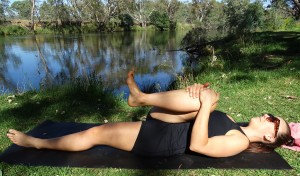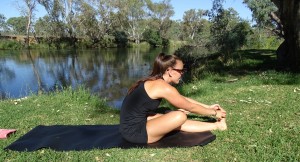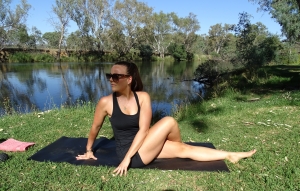WHAT IS SCIATICA?
Sciatica refers to the Sciatic nerve that runs down the lower back, through the glute, down the middle of the hamstrings and into the back of the leg. When the muscles and fascia (Piriformis, Hamstrings, Quadratus Lumborum, Psoas and other large musculature of the hip and leg) become tight and shortened they impinge, inflame and irritate the sciatic nerve.
The sciatic nerve is responsible for supplying sensation, pain, feeling and strength to the leg which in turn transmits impulses that gives the muscles movement. It connects the spinal cord with the outside of the thigh – which is why you lose function and get symptoms of pain to the glute and thigh when the nerve is impinged.
Regular deep tissue treatments can lengthen shortened and restricted fascia around the sciatic nerve, as self-care is the number one step in preventing sciatica.
Strengthening exercises to the glutes, lower back and psoas muscles can help alleviate pain and ensure optimal function of the muscles that surround the sciatic nerve.

Reference: http://www.elkhartchiropractors.com/sciatic-nerve-pain.html
CAUSES/RISK FACTORS
Sciatica can be associated with age related symptoms in the spine such as wear and tear on the vertebra that results in pressure on the sciatic nerve root L5-S1, as well as obesity and it is very common in pregnant women.
The sciatic nerve can be compressed by the discs of the lumbar spine, muscle spasms, fascial tightness, a dysfunctional pelvis or the pinching of a nerve root within the back e.g. facet joint compression, disc buldge, protrusion, extrusion all causing it to send sharp shooting pains down the leg of the affected side.
Other factors include
- Age (sciatica is more common between 30 and 50 years of age)
- Diabetes (increases the risk of nerve damage)
- Genetics (e.g., inherited spine abnormalities)
- Menopause (ending of menstrual periods in women; may lead to bone loss)
- Physical activities that involve heavy lifting or twisting the back (e.g., golf)
- Sedentary (inactive) lifestyle, including occupations that require sitting for long periods of time
- Injury (e.g., fractured pelvis)
- Pinched nerve (pressure from surrounding bone, cartilage, muscles, or tendons)
- Piriformis syndrome (caused by tightening or spasm of the piriformis muscle in the buttock)
- Spinal stenosis (narrowing of the spinal column)
- Spondylolisthesis (condition in which one vertebra slips forward and out of line; may occur as a result of damage to the vertebra [e.g., degeneration, spondylolysis] or spinal defects [e.g., spinal bifida])
- Herniated discs
SYMPTOMS
Most commonly you will describe glute and leg pain consisting of
- Sharp, stabbing, burning nature rather than an ache.
- Pain along the length of the Sciatic nerve
- Numbness and tingling (pins and needles)
- Muscle weakness
- Sensitivity to touch
- Difficulty moving legs
- Increased pain when sitting
RISK FACTORS
Certain activities can increase your risk of sciatica pain including;
- Bending from the waist (instead of the knees) or twisting the back.
- Long periods of inactivity – work and leisure (e.g., during sleep, sitting at a desk for 8 hours).
- Excessive coughing, sneezing, laughing – due to the spasm of muscles involved in these processes (most commonly the quadratus lumborum).
- More prominent in pregnant women as the growing of the uterus puts added pressure on the sciatic nerve.
Therefore, it is important to incorporate lifestyle changes to minimise the risk. Start by reducing the length of time you spend sitting on the couch or at a desk at work and driving in a car. Break the day up with frequent stretching or brief walks (aggressive stretching can cause symptoms to worsen so start lightly).
OUTCOMES TREATMENTS
- Deep tissue massage to the lumbar spine, glutes, ITB, piriformis to allow softening and restoration of a better range of motion for less pain and restriction.
- Dry needling to the muscles responsible for impinging the nerve.
- Kinesiology taping to apply compression to promote recovery and decompression to relieve pain and swelling. This tape lifts the skin, accelerating blood flow to increase the amount of oxygen available to the muscles which reduces fatigue.
- Heat to warm and lengthen the fibres and take pressure off the discs compressing the sciatic nerve.
- Gentle Mobilisation to the sacrum, coccyx bone and hip joint to regain mobility.
PREVENTITIVE MEASURES
- Avoid smoking, which may increase intervertebral disc degeneration.
- Eat a healthy diet and maintain a healthy weight.
- Exercise regularly to strengthen back and abdominal muscles.
- Maintain good posture (especially when sitting or standing for long periods of time.
- Practice proper body mechanics when lifting (e.g., keep the back straight and lift using the legs and hips), bending, and twisting.
EXERCISE PRESCRIPTION
- Hamstring, glutes, Quadratus lumborum, back muscles.
- Rolling on a trigger point ball or foam roller – lay over the pressure point for as long as needed for the muscle to release.

Hamstring & Back Stretch

Glute Stretch – opposite knee to opposite Shoulder

Hamstring, calf and back stretch – pull toes towards body.

Glute stretch – both knees bent, straight back
Cross ankle over opposite knee and lean into it

Alternate glute stretch – pull hamstring towards
body to feel the stretch in the glute.

Glute/lower back/hamstring stretch

Glute Stretch
Glute Stretch

Hamstring & back stretch

Seated glute stretch

Child’s Pose – ideal for opening back muscles in the posterior chain.
stretches lats, lower back and glutes.
**If you are experiencing pain, discomfort or an injury you are unsure of please seek professional advice from a doctor or your Myo/Phyio as this is general advice and is not to be used in replacement of**

Thanks Courtney! This is great, these stretches will be really useful.
LikeLike